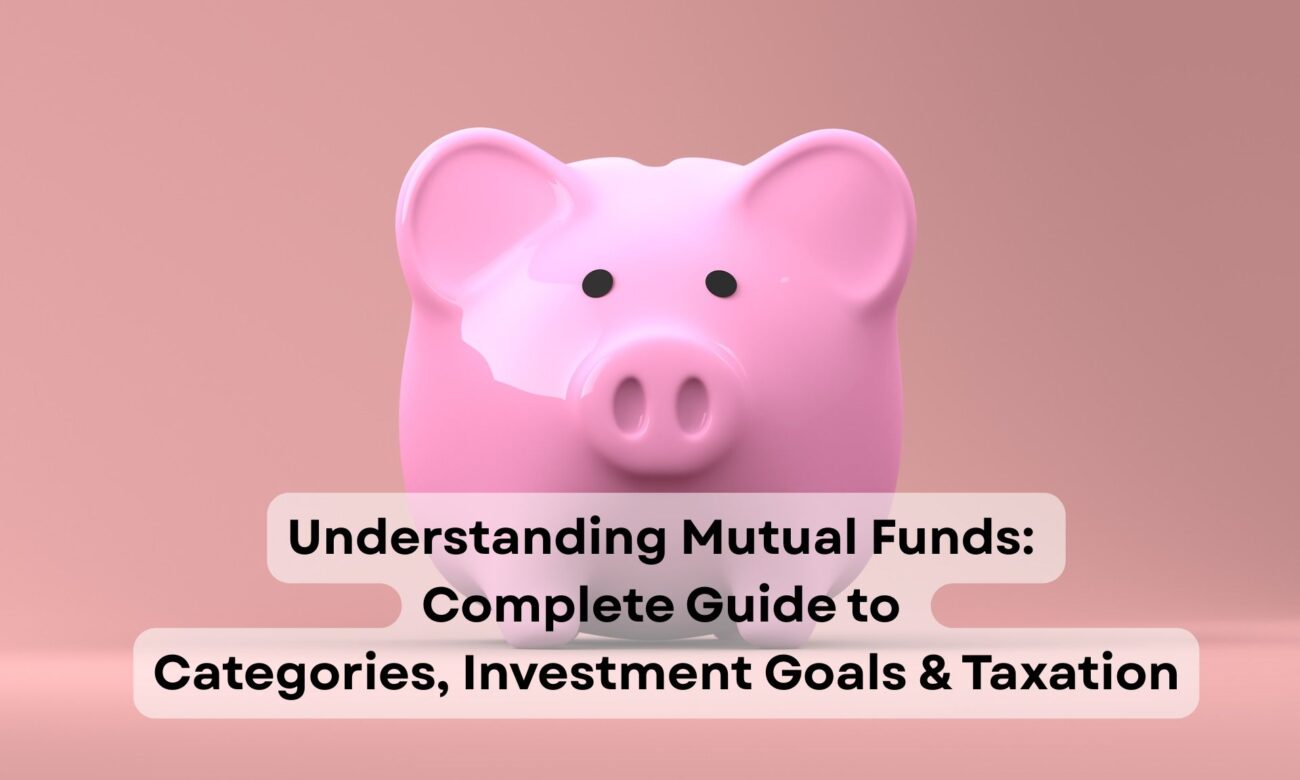📘 Introduction: Why Understanding Mutual Funds is Essential
Mutual funds have emerged as one of the most popular investment instruments for individuals looking to grow wealth steadily 📈. They offer diversification, professional management, and accessibility, making them an ideal choice for both beginners and seasoned investors.
However, with a wide variety of mutual funds available in India 🇮🇳, understanding the categories, risk profiles, taxation, and aligning them with personal financial goals is crucial before investing. This comprehensive guide breaks down everything you need to know.
💡 What Are Mutual Funds?

A mutual fund is a pooled investment vehicle where money from multiple investors is collected and invested in securities like stocks, bonds, and other assets 💰📊. Managed by professional fund managers, these funds aim to generate returns based on the investment objective.
🗂️ Categories of Mutual Funds
1. 📊 Equity Mutual Funds
Equity mutual funds primarily invest in stocks or shares of companies. These funds aim for capital appreciation and are best suited for long-term investors who can withstand short-term volatility.
Sub-categories:
- 🏢 Large Cap Funds: Invest in well-established companies with large market capitalization. Lower risk among equities.
- 🏭 Mid Cap Funds: Focus on medium-sized companies with potential for higher growth. Higher risk than large caps.
- 🏗️ Small Cap Funds: Invest in smaller, emerging companies. High risk, high reward.
- 🔄 Multi Cap Funds: Invest across large, mid, and small caps, offering diversified equity exposure.
- 🧠 Sectoral/Thematic Funds: Invest in specific sectors (like pharma, IT) or themes. High-risk, suitable for experienced investors.
- 💸 ELSS (Tax-saving Funds): Equity funds with a 3-year lock-in offering tax deductions under Section 80C.
- 🎯 Focused Funds: Invest in a limited number of stocks (up to 30). High conviction bets with concentrated risk.
2. 🧾 Debt Mutual Funds
Debt mutual funds invest in fixed-income instruments like government securities, treasury bills, and corporate bonds. They are suitable for conservative investors 🛡️.
Sub-categories:
- 💧 Liquid Funds: Invest in very short-term instruments. Low risk, suitable for parking surplus funds.
- 🌙 Overnight Funds: Invest in securities with a maturity of one day. Extremely low risk.
- 🕓 Short Duration Funds: Invest in bonds with 1–3 years duration. Good for short-term goals.
- 📆 Medium Duration Funds: Hold securities with 3–4 years maturity. Moderate risk and return.
- 🏛️ Long Duration Funds: Invest in long-term debt instruments. Sensitive to interest rate changes.
- 🏦 Gilt Funds: Invest only in government securities. No credit risk, but subject to interest rate risk.
- ⚠️ Credit Risk Funds: Invest in lower-rated corporate bonds offering higher returns. Higher credit risk.
3. ⚖️ Hybrid Mutual Funds
Hybrid funds invest in both equity and debt instruments to balance risk and reward 🧮.
Sub-categories:
- 📈 Aggressive Hybrid Funds: 65–80% in equity, rest in debt. Suited for moderate-to-high risk investors.
- 📉 Conservative Hybrid Funds: 75–90% in debt, remaining in equity. Lower risk, stable returns.
- 🔁 Balanced Advantage Funds: Dynamically adjust equity-debt mix based on market conditions.
- 🌐 Multi Asset Allocation Funds: Invest in at least three asset classes—equity, debt, and gold/commodities.
4. 🎯 Solution-Oriented Mutual Funds
These funds are designed to help investors achieve specific long-term goals like retirement or children’s education 👨👩👧👦.
Sub-categories:
- 👴 Retirement Funds: Long lock-in periods and moderate-to-high equity exposure to build a retirement corpus.
- 👶 Children’s Funds: Tailored for children’s future expenses like education or marriage with a lock-in period.
5. 🌍 Other Mutual Fund Categories
- 📉 Index Funds: Passively track a stock market index like Nifty or Sensex. Lower cost, market returns.
- 🧺 Fund of Funds (FoF): Invest in other mutual funds. Offer diversification across strategies.
- ✈️ International Funds: Invest in global equity or debt markets. Ideal for global diversification.
⏳ Schemes Based on Maturity Period
1. 🔓 Open-Ended Funds
- No maturity date
- Can be bought/sold anytime
2. 🔐 Close-Ended Funds
- Fixed maturity period
- Can only be bought during NFO (New Fund Offer)
3. 🔁 Interval Funds
- Open for investment at specific intervals
💼 Schemes Based on Principal Investments
1. 📈 Growth Option
- Returns are reinvested
- Gains realized when units are sold
2. 💵 Dividend Option
- Periodic payouts made to investors
👥 Who Should Invest in…
🔷 Equity Mutual Funds?
- Individuals with long-term goals (5+ years)
- High-risk appetite
- Goal: wealth creation, retirement corpus, child’s future 🎯
🔷 Debt Mutual Funds?
- Short to medium-term goals (1–3 years)
- Conservative investors 🛡️
- Goal: capital preservation with modest returns
🔷 Hybrid Mutual Funds?
- Moderate risk appetite ⚖️
- Need a balance between equity growth and debt stability
- Ideal for first-time investors
🔷 Solution-Oriented Mutual Funds?
- Specific goals like retirement planning or child education 🎯
- Investors willing to lock-in funds for a long period
🔷 Index Funds?
- Passive investors 🧘
- Want market returns at low cost
- Ideal for long-term hands-off investing
✅ Points to Consider Before Investing
- ⚖️ Risk Tolerance: Assess your ability to handle market volatility.
- 🎯 Investment Goals: Define clear financial objectives.
- ⏰ Time Horizon: Match fund type with duration of investment.
- 📊 Fund Performance: Evaluate historical performance and consistency.
- 💸 Expense Ratio: Lower ratio means higher returns.
- 👤 Fund Manager’s Track Record: Experience matters.
- 🧾 Tax Implications: Consider impact on returns.
🧭 Who Should Invest in Which Mutual Fund?
🎯 Based on Financial Goals:
- Short-term (0–2 years): Liquid or Ultra Short-Term Debt Funds 💧
- Medium-term (2–5 years): Hybrid Funds, Balanced Advantage Funds ⚖️
- Long-term (5+ years): Equity Funds, ELSS, Index Funds 📈
🔐 Based on Risk Tolerance:
- Low Risk: Debt Funds, Conservative Hybrid 🛡️
- Moderate Risk: Balanced Advantage, Multi-Asset Funds ⚖️
- High Risk: Equity Funds, Sectoral Funds ⚠️
💰 Based on Investment Timeline:
- Monthly Investments: SIP in Equity or Hybrid Funds 📅
- Lump Sum Investments: Debt Funds, Index Funds 💼
🧾 Taxation of Mutual Funds

1. 📈 Equity Funds
- Short-Term Capital Gains (STCG): 15% (if held < 1 year)
- Long-Term Capital Gains (LTCG): 10% beyond Rs. 1 lakh (if held > 1 year)
2. 🧾 Debt Funds (from April 1, 2023)
- Gains taxed as per investor’s income tax slab, irrespective of holding period
3. 💸 Dividend Taxation
- Dividend added to investor’s income and taxed as per slab rate
🏢 Top Asset Management Companies (AMCs) in India
- SBI Mutual Fund 🏦
- ICICI Prudential Mutual Fund 🏢
- HDFC Mutual Fund 🏛️
- Nippon India Mutual Fund 🇯🇵
- Kotak Mahindra Mutual Fund 🧭
- UTI Mutual Fund 🧾
- Axis Mutual Fund 🔼
- Aditya Birla Sun Life Mutual Fund ☀️
- Mirae Asset Mutual Fund 🌐
- DSP Mutual Fund 📉
📌 Final Thoughts
Investing in mutual funds can help you achieve your financial goals efficiently if done with planning and discipline. Always align your investment strategy with your risk appetite, time horizon, and future objectives 🧭.
Remember, mutual funds are not about timing the market but time in the market. Start early, stay consistent, and watch your wealth grow 🌱.
❓ FAQs:

- What are mutual funds in simple terms? Mutual funds pool money from many investors to invest in various securities 📊.
- Which mutual fund is best for beginners? Balanced or Hybrid funds ⚖️ are ideal for beginners due to moderate risk.
- Are mutual funds safe? They carry varying risks depending on the type – debt is safer than equity 🛡️.
- How much should I invest in mutual funds? Depends on your income, goals, and risk appetite 🎯. Start small via SIP.
- What is SIP? Systematic Investment Plan allows investing fixed amounts periodically 💸.
- How are mutual funds taxed? Taxed based on type equity or debt and duration of holding 🧾.
- Can I lose money in mutual funds? Yes, especially in equity funds during market downturns 📉.
- What is NAV? Net Asset Value—price per unit of a mutual fund 💰.
- Is KYC mandatory to invest? Yes, KYC is mandatory for all mutual fund investors in India 📄.
- When is the best time to invest in mutual funds? The best time is now—start early and invest consistently ⏰.
⚠️ Disclaimer
This article is for educational purposes only. Investing in mutual funds is subject to market risks. Consult your advisor before making any investment decisions. Returns are not guaranteed and may vary based on market conditions.


9 thoughts on “Understanding Mutual Funds: Complete Guide to Categories, Investment Goals & Taxation”